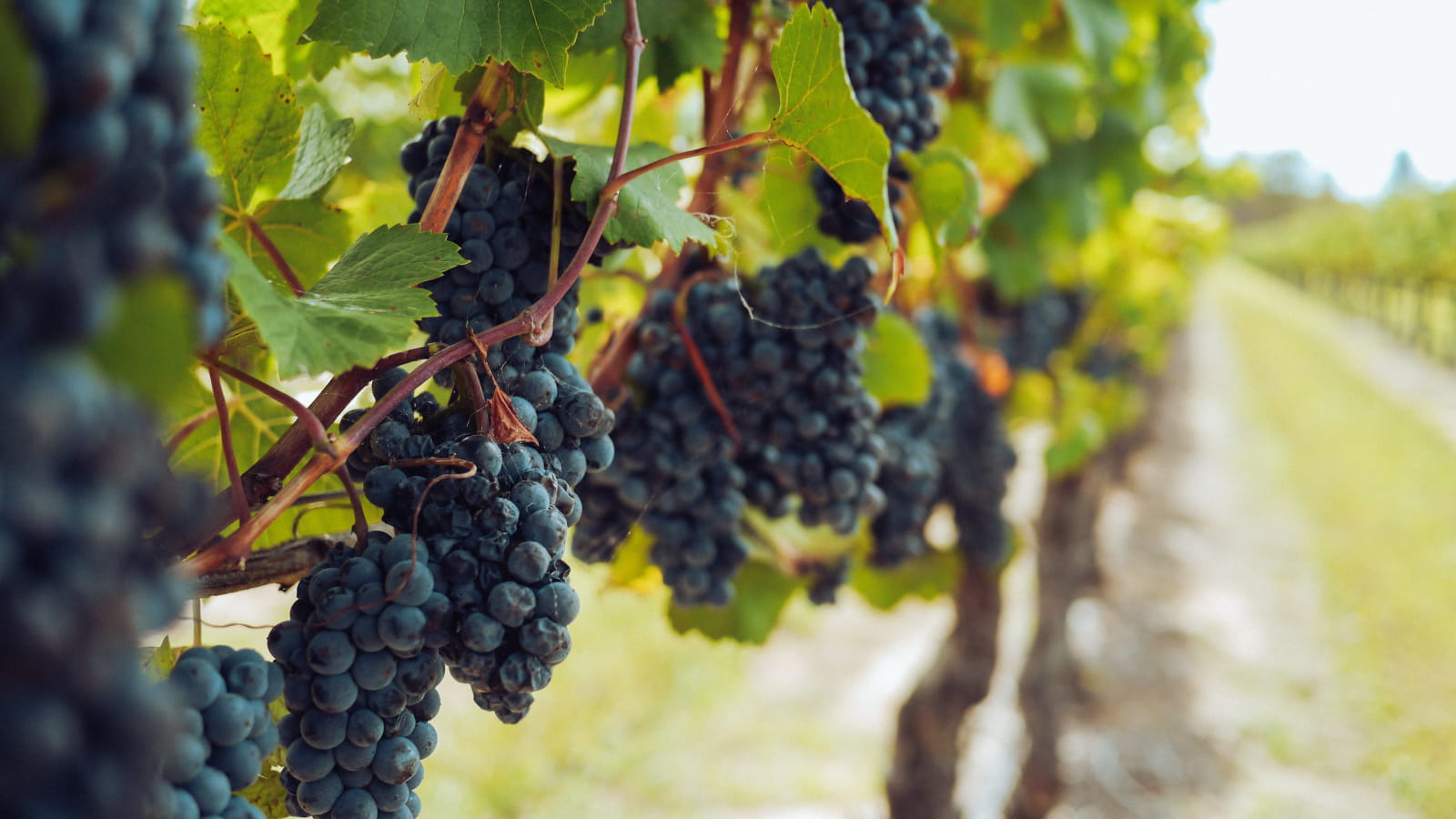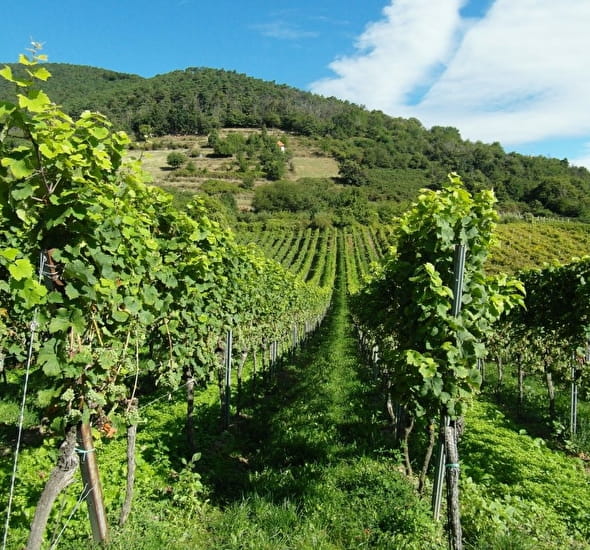

The vineyards of Strasbourg
The vineyard in all its splendor
Only 20 kilometers from the Alsatian capital, come and explore the vineyards around Strasbourg, stretching from Marlenheim to Molsheim through astonishing medieval heritage and lush landscapes blending vineyards and orchards. As the northern gateway to the Alsace Wine Route, follow this route to discover a plethora of typical villages and fortified towns, and take one of the many wine trails to uncover all the secrets of the Golden Crown Vineyard ! Whether by car, on foot, or by bike, set out to explore the vineyards and make stops directly at the cellars and wineries to learn more about the production of Alsace wines.
The first town to discover is Marlenheim, known as the 'Gateway to the Alsace Wine Route,' just a few minutes from Strasbourg. Explore the town center and discover its particularly diverse architectural heritage: the Catholic church of Sainte-Richarde, the 18th-century town hall and castle, Renaissance residences, and half-timbered houses that bear witness to its past prosperity. Take a walk in the heights of Marlenheim and enjoy breathtaking views of the Alsatian vineyards and the Strasbourg Cathedral. On Marlenberg hill, you can visit the Romanesque Chapel and its Stations of the Cross.

Nordheim, literally meaning 'the dwelling located to the north.' Come and discover the Stephansberg hill, which houses a TDF antenna installed at the summit, visible from afar. This hill offers an exceptionally beautiful panoramic view that rewards the increasing number of visitors. This village has many assets, including its remarkable viewpoint and preserved nature accessible through various walking paths, its vineyards with wines and sparkling wines that you can taste at three wineries. You can pair these fine wines with the numerous goat-based products provided by the Cabri farm.

Nestled against the slopes of Wangenberg, which rises to 391 meters, the small town of Wangen seems immersed in a tranquility reminiscent of a fairy tale setting. With 670 inhabitants, Wangen is wisely removed from the noise and traffic hassles. To further preserve this serenity, the city is guarded by two medieval gates that restrict any high loads or passage. For the walker, Wangen becomes a peaceful corner of land to explore. When visitors arrive in Wangen by climbing the hill from the Mossig valley, they inevitably find themselves in front of the 'Niedertor,' the lower gate.

Odratzheim is a very ancient village with a population of 499 residents. Bordering the villages of Kirchheim and Scharrachbergheim-Irmstett, it's possible to take a stroll through its limestone hill called 'am Berg,' which rises to 246 meters. An important Jewish community was documented in the village, having apparently settled there in the 16th century after being expelled from Strasbourg. The synagogue was built in the 18th-19th century, only to witness the decline of the community. The building was sold to the municipality in 1952 and transformed into a Sports and Sociocultural Center in 1985.

The charming village of Westhoffen, with its 1,675 inhabitants, boasts the largest vineyard in the 'Golden Crown,' covering 235 hectares. The village is also known and celebrated as the capital of Alsatian cherries, with no less than 5,000 cherry trees. Embraced by vineyards and orchards, its heritage is revealed both culturally and gastronomically, as well as from a medieval perspective. By stopping in this typically Alsatian village, you'll enjoy strolling through its narrow streets, walking along its ramparts, and reaching the beautiful Geierstein Geierstein, which blooms in spring.

Take a gourmet break upon arriving in Traenheim, where you can taste Alsatian wines at the renowned Cave du Roi Dagobert. Across the way, stock up on local products and apple juice at the Rothgerber Farm, and enjoy a meal on-site to savor farm-fresh products. You'll be even more enchanted as you gaze upon the impressive Mount Sharrach unfolding before you. The village was once the property of King Dagobert II. Stroll through the center of Traenheim to discover its church and some beautiful, old Alsatian houses.

This charming village occupies a site that was already frequented during the Neolithic period ! Strolling through its narrow and picturesque streets, you can admire many remnants of its long history : windows and grotesque heads dating back to the 11th century, the steeple of the Protestant church, which also houses a sandstone pulpit from the 17th century and a marquetry wood altar from 1701, the castle built around 1450 and restored several times, beautiful half-timbered houses... The strategic importance of the commune did not escape the German War Ministry : it erected a casemate at the summit of Mont Scharrach hill in 1914.

Famous for its Grand Cru Altenberg, Bergieten is one of the first classified terroirs (mentioned as early as the 11th century). The village is nestled in a valley surrounded by vineyards, much to the delight of its residents and local winemakers. Mentioned as early as 1120, what was then just a hamlet belonged to the bishops of Strasbourg. The castle was destroyed during the Thirty Years' War (1618-1648), so today, only a few ramparts remain as witnesses to its tumultuous past. Interestingly, 7,000 silver coins from the 13th century were found there and are now exhibited in Berlin. Quite a treasure trove!

Neighboring the village of Westhoffen, Balbronn welcomes you to the heart of its tranquility. Make your experience more unique by visiting the Craft Distillery Hagmeyer and perhaps indulging in a tasting session. Pique your curiosity by visiting the fortified church, whose religious history has often oscillated between Catholicism and Protestantism, even sharing the same church simultaneously for a period. Inside, you will find a replica of the iron hand of the knight Hans Von Mittelhausen and a restored Silbermann organ. If you're lucky, you might even attend an organ concert !

The municipality, documented as early as 884 in a charter listing the assets of the Hanau Abbey, possesses one of the first Neoclassical buildings in Alsace: the Saint-Blaise Church, erected in 1774, which stands with proud austerity in this winegrowing commune. Numerous trails laden with information to introduce the region's vineyards wind through the vineyards on the hills of Scharrach and Engelberg, offering splendid views of the Alsace plain, Strasbourg, and the Vosges. A delightful discovery to be made with family or friends and in all seasons.

The last village at the border of the Wasselonne canton, Dangolsheim impresses with its Saint Pancrace Church overlooking the commune. This village unveils itself and reveals a rich history and offers numerous points of interest : the Fort of Mutzig, a remarkable military structure, the communal washhouse, sculpted porches, and the organs, of which the instrumental part is classified as a historical monument. A significant part of the Dangolsheim forest is classified as 'military terrain' and houses the public-access museum section of the 'Feste Kayser Wilhelm II' (Fort de Mutzig), built from 1893 to 1917.

Embark on a journey to discover wineries and vineyards :
Embark on your vacation in Alsace for a gourmet and oenological experience by visiting the winemakers: each encounter is an opportunity to savor the riches of this terroir and to taste, in moderation, the delights of Alsace wines. Within the various welcoming cellars and wineries, you can taste exceptional wines and learn all about the production and traditions of Alsace wines. The months of September and October are ideal for exploring: it's the prime wine season when the vineyards gradually turn russet, and the harvests give the region a unique atmosphere...






